Asparagus (Black Diamond) Traditional Cache
K.E.T.: It looks like this is gone.
Asparagus (Black Diamond)
-
Difficulty:
-

-
Terrain:
-

Size:  (small)
(small)
Please note Use of geocaching.com services is subject to the terms and conditions
in our disclaimer.

Asparagus surprised me at the start of the Black Diamond Trail. N 42 26.832 W 76 30.915. Please check it out as you go by.The cache had to be moved about 1 mile up the trail, due to cache saturation.
As always BYOP.
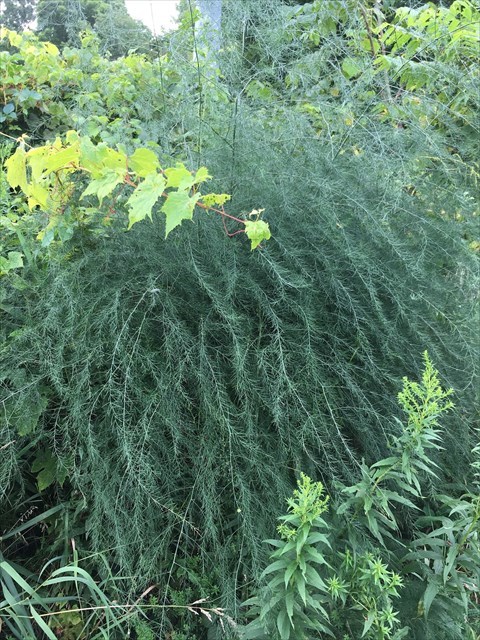
Asparagus is a genus of flowering plants in the family Asparagaceae, subfamily Asparagoideae. It comprises up to 300 species.
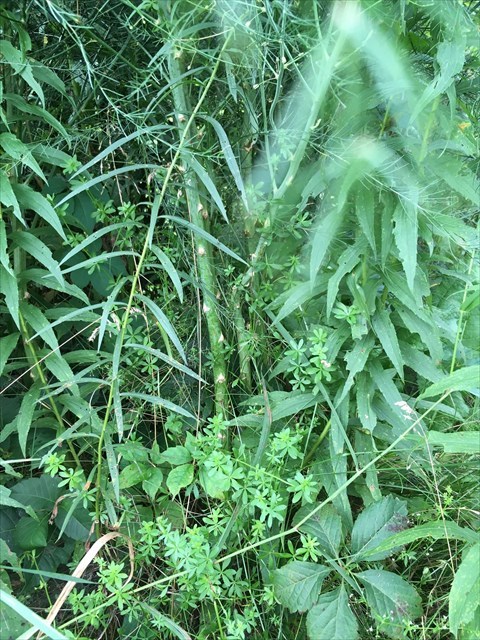
Most are evergreen long-lived perennial plants growing from the understory as lianas, bushes or climbing plants. The best-known species is the edible Asparagus officinialis, commonly referred to as just asparagus. Some other members of the genus, such as Asparagus densiflorus, are grown as ornamental plants.
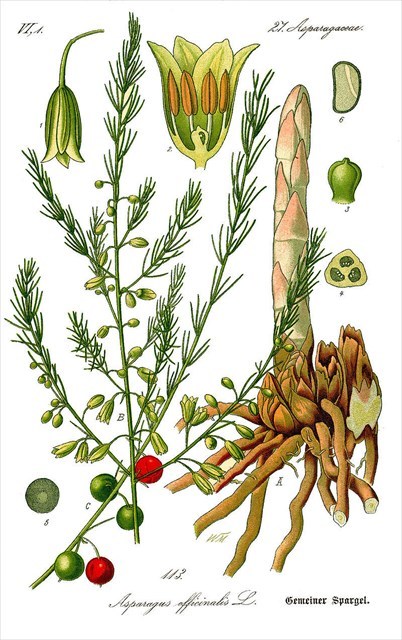
German botanical illustration of asparagus
Asparagus, or garden asparagus, scientific name Asparagus officinalis, is a spring vegetable, a flowering perennial plant species in the genus Asparagus.

Asparagus in Mildura, Victoria, Australia
It was once classified in the lily family, like the related Allium species, onions and garlic, but the Liliaceae have been split and the onion-like plants are now in the familyAmaryllidaceae and asparagus in the Asparagaceae. Asparagus officinalis is native to most of Europe, northern Africa and western Asia, and is widely cultivated as a vegetable crop.
Asparagus is a herbaceous, perennial plant growing to 100–150 cm (39–59 in) tall, with stout stems with much-branched, feathery foliage. The "leaves" are in fact needle-like cladodes (modified stems) in the axils of scale leaves; they are 6–32 mm (0.24–1.26 in) long and 1 mm (0.039 in) broad, and clustered four to 15 together, in a rose-like shape. The root system is adventitious and the root type is fasciculated. The flowers are bell-shaped, greenish-white to yellowish, 4.5–6.5 mm (0.18–0.26 in) long, with six tepals partially fused together at the base; they are produced singly or in clusters of two or three in the junctions of the branchlets. It is usually dioecious, with male and female flowers on separate plants, but sometimes hermaphrodite flowers are found. The fruit is a small red berry 6–10 mm diameter, which is poisonous to humans.
Plants native to the western coasts of Europe (from northern Spain north to Ireland, Great Britain, and northwest Germany) are treated as Asparagus officinalis subsp. prostratus (Dumort.) Corb., distinguished by its low-growing, often prostrate stems growing to only 30–70 cm (12–28 in) high, and shorter cladodes 2–18 mm (0.079–0.709 in) long. It is treated as a distinct species, Asparagus prostratus Dumort, by some authors.
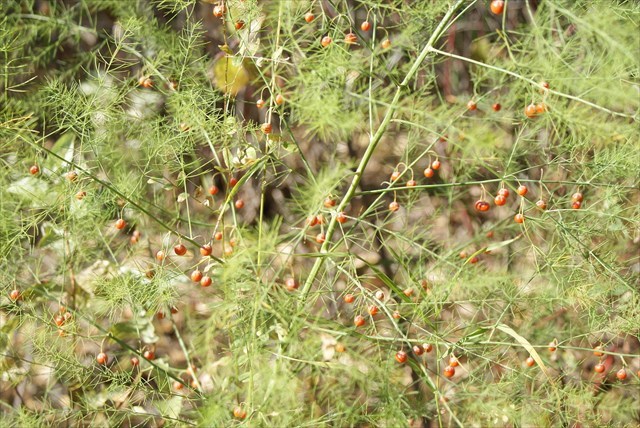
Mature native asparagus with seed pods in Saskatchewan, Canada
History
Asparagus has been used as a vegetable and medicine, owing to its delicate flavour, diuretic properties, and more. It is pictured as an offering on an Egyptian frieze dating to 3000 BC. In ancient times, it was also known in Syria and in Spain. Greeks and Romans ate it fresh when in season, and dried the vegetable for use in winter; Roman Epicureans even froze it high in the Alps, for the Feast of Epicurus. Emperor Augustus created the "Asparagus Fleet" for hauling the vegetable, and coined the expression "faster than cooking asparagus" for quick action. A recipe for cooking asparagus is in the oldest surviving book of recipes, Apicius's third-century AD De re coquinaria, Book III.
The ancient Greek physician Galen (prominent among the Romans) mentioned asparagus as a beneficial herb during the second century AD, but after the Roman empire ended, asparagus drew little medieval attention until al- Nafzawi’’s The Perfumed Garden. That piece of writing celebrates its (scientifically unconfirmed) aphrodisiacal power, a supposed virtue that the Indian Ananga Ranga attributes to "special phosphorus elements" that also counteract fatigue. By 1469, asparagus was cultivated in French monasteries. Asparagus appears to have been hardly noticed in England until 1538, and in Germany until 1542.
The finest texture and the strongest and yet most delicate taste is in the tips. The points d'amour ("love tips") were served as a delicacy to Madame de Pompadour. Asparagus became available to the New World around 1850, in the United States.
Uses
Only young asparagus shoots are commonly eaten: once the buds start to open ("ferning out"), the shoots quickly turn woody.
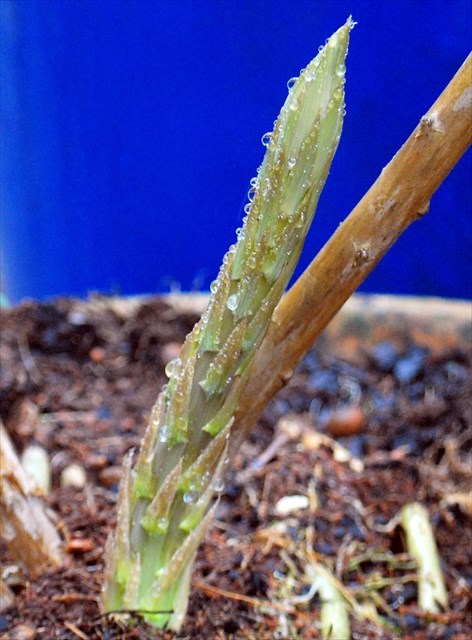
Asparagus shoot before becoming woody
Water makes up 93% of asparagus's composition. Asparagus is low in calories and is very low in sodium.
The shoots are prepared and served in a number of ways around the world, typically as an appetizer or vegetable side dish. In Asian-style cooking, asparagus is often stir-fried. Cantonese restaurants in the United States often serve asparagus stir-fried with chicken, shrimp, or beef. It may also be quickly grilled over charcoal or hardwood embers, and is also used as an ingredient in some stews and soups. In recent years, asparagus eaten raw, as a component of a salad, has regained popularity.
Asparagus can also be pickled and stored for several years. Some brands label shoots prepared in this way as "marinated".
Stem thickness indicates the age of the plant, with the thicker stems coming from older plants. Older, thicker stalks can be woody, although peeling the skin at the base removes the tough layer. Peeled asparagus will poach much faster. The bottom portion of asparagus often contains sand and soil, so thorough cleaning is generally advised before cooking.
Green asparagus is eaten worldwide, though the availability of imports throughout the year has made it less of a delicacy than it once was. In Europe, however, the "asparagus season is a highlight of the foodie calendar"; in the UK this traditionally begins on 23 April and ends on Midsummer Day. As in continental Europe, due to the short growing season and demand for local produce, asparagus commands a premium price.
White asparagus in continental northwestern Europe
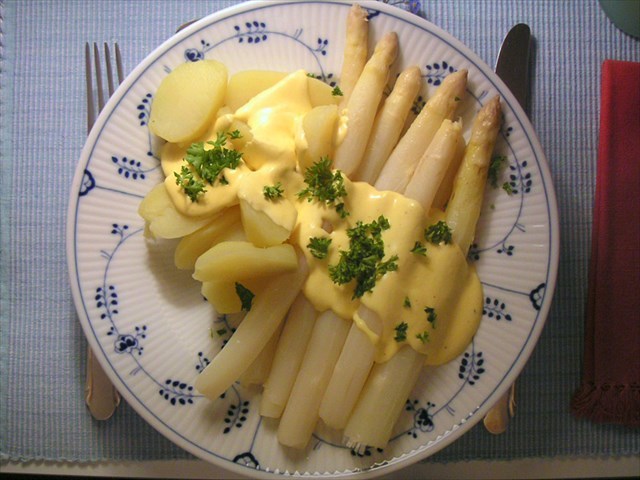
Typical serving of asparagus with Hollandaise sauce and potatoes
Asparagus is very popular in the Netherlands, Spain, France, Poland, Belgium, Germany, Austria, Turkey, Italy, and Switzerland, and is almost exclusively white; if not, it is specified by the local language term for "green asparagus". White asparagus is the result of applying a blanching technique while the asparagus shoots are growing. To cultivate white asparagus, the shoots are covered with soil as they grow, i.e. earthed up; without exposure to sunlight, no photosynthesis starts, and the shoots remain white. Compared to green asparagus, the locally cultivated so-called "white gold" or "edible ivory" asparagus, also referred to as "the royal vegetable", is believed to be less bitter and much tenderer. Freshness is very important, and the lower ends of white asparagus must be peeled before cooking or raw consumption.
Only seasonally on the menu, asparagus dishes are advertised outside many restaurants, usually from late April to June. For the French style, asparagus is often boiled or steamed and served with Hollandaise sauce, melted butter or olive oil, Parmesan cheese, or mayonaise. Tall, narrow asparagus cooking pots allow the shoots to be steamed gently, their tips staying out of the water.
During the German Spargelsaison or Spargelzeit ("asparagus season" or "asparagus time"), the asparagus season that traditionally finishes on 24 June, roadside stands and open-air markets sell about half of the country's white asparagus consumption.
Cultivation
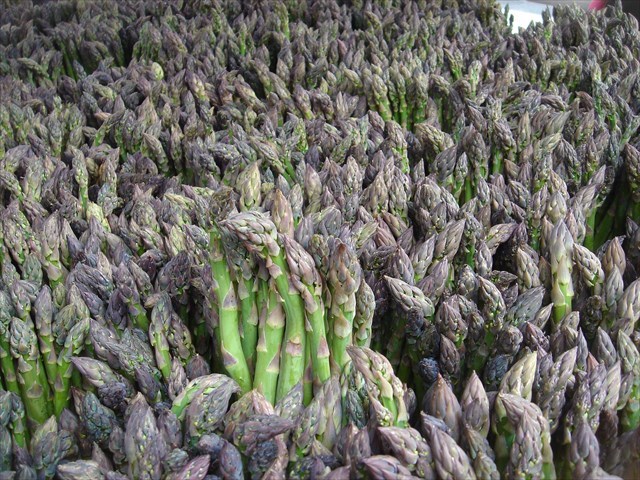
Green asparagus for sale in New York City
Since asparagus often originates in maritime habitats, it thrives in soils that are too saline for normal weeds to grow. Thus, a little salt was traditionally used to suppress weeds in beds intended for asparagus; this has the disadvantage that the soil cannot be used for anything else. Some places are better for growing asparagus than others. The fertility of the soil is a large factor. "Crowns" are planted in winter, and the first shoots appear in spring; the first pickings or "thinnings" are known as sprue asparagus. Sprue has thin stems.
A new breed of "early season asparagus" that can be harvested two months earlier than usual was announced by a UK grower in early 2011. This variety does not need to lie dormant and blooms at 7 °C (45 °F) rather than the usual 9 °C (48 °F).
Purple asparagus differs from its green and white counterparts in having high sugar and low fibre levels. Purple asparagus was originally developed in Italy, near the city of Albenga and commercialized under the variety name 'Violetto d' Albenga'. Since then, breeding work has continued in the United States and New Zealand, creating the 'Pacific Purple' variety.
Companion planting
Asparagus is said to be a useful companion plant for tomatoes, as the tomato plant repels the asparagus beetle. Asparagus may repel some harmful root nematodes that affect tomato plants.
Commercial production
The top asparagus importers (2013) were the United States (182,805 tonnes), followed by the European Union (external trade) (94,475 tonnes), and Canada (20,219 tonnes).
China is by far the world's largest producer: in 2013 it produced 7,000,000 tonnes, followed by Peru with 383,144 tonnes and Mexico with 126,421 tonnes. U.S. production was concentrated in California, Michigan and Washington. The annual production for white asparagus in Germany is 57,000 tonnes (61% of consumer demand).
When growing under tunnels growers can increase the growth season. In Britain it is estimated that the harvest season of asparagus grown under tunnels can be from February to November.
Celebrations
The green crop is significant enough in California's Sacramento-San joaquin River Delta region that the city of Stockton holds a festival every year to celebrate it, as does the city of Hart, Michigan, complete with a parade and asparagus queen. The Vale of Evesham in Worcestershire is the largest producer within Northern Europe, celebrating with the annual British Asparagus Festival involving auctions of the best crop, an "Asparagus Run" modelled on the Beaujolais Run and a weekend "Asparafest" music festival.
Many German cities hold an annual Spargelfest (asparagus festival) celebrating the harvest of white asparagus. Schweitzingen claims to be the "Asparagus Capital of the World", and during its festival, an Asparagus Queen is crowned. The Bavarian city of Nurenberg feasts a week long in April, with a competition to find the fastest asparagus peeler in the region. This usually involves generous amounts of the local wines and beers being consumed to aid the spectators' appreciative support.
Helmut Zipner holds the current world record in asparagus peeling.
Vernacular names and etymology
A. officinalis is widely known simply as "asparagus", and may be confused with unrelated plant species also known as "asparagus", such as Ornithogalum pyrenaicum known as "Prussian asparagus" for its edible shoots.
The English word "asparagus" derives from classical Latin, but the plant was once known in English as sperage, from the Medival Latin sparagus. This term itself derives from the Greek aspharagos or asparagos, and the Greek term originates from the Persian asparag, meaning "sprout" or "shoot". Asparagus was also corrupted in some places to "sparrow grass"; indeed, John Walker wrote in 1791 that "Sparrowgrass is so general that asparagus has an air of stiffness and pedantry".The name 'sparrow grass' was still in common use in rural Eat Anglia, England well into the twentieth century.
In East Asia, A. officinalis is known in Vietnamese as măng tây which literally mean "European bamboo shoots" and "Western bamboo shoots", respectively. The green asparagus is commonly used in Chinese-American cuisine and Thai cuisine.
In Turkish, asparagus is known as kuşkonmaz, literally "[a] bird won't land [on it]," in reference to the shape of the plant.
Effects on urine
The effect of eating asparagus on urine excreted afterwards has long been observed:
"[Asparagus] cause a powerful and disagreeable smell in the urine, as everybody knows." (Treatise of All Sorts of Foods, Lois Lemery, 1702)
"asparagus... affects the urine with a foetid smell (especially if cut when they are white) and therefore have been suspected by some physicians as not friendly to the kidneys; when they are older, and begin to ramify, they lose this quality; but then they are not so agreeable."
Asparagus contains asparagus acid. When the vegetable is digested, this chemical is broken down into a group of related sulfur-containing compounds.
Debate exists about the universality of producing the sulfurous smell, as well as the ability to detect it. Originally, this was thought to be because some people digested asparagus differently from others, so some excreted odorous urine after eating asparagus, and others did not. In the 1980s, three studies from France, China, and Israel published results showing that producing odorous urine from asparagus was a common human characteristic. The Israeli study found that from their 307 subjects, all of those who could smell "asparagus urine" could detect it in the urine of anyone who had eaten asparagus, even if the person who produced it could not detect it. A 2010 study found variations in both production of odorous urine and the ability to detect the odor, but that these were not tightly related. Most people are thought to produce the odorous compounds after eating asparagus, but the differing abilities of various individuals to detect the odor at increasing dilutions suggests a genetically determined specific sensitivity.
In 2010, the company 23andMe published a genome-wide association study on whether participants have "ever noticed a peculiar odor when you pee after eating asparagus?” This study pinpointed a single-nucleotide polymorphism (SNP) in a cluster of olfactory genes associated with the ability to detect the odor. While this SNP did not explain all of the difference in detection between people, it provides support for the theory that genetic differences occur in olfactory receptors that lead people to be unable to smell these odorous compounds.
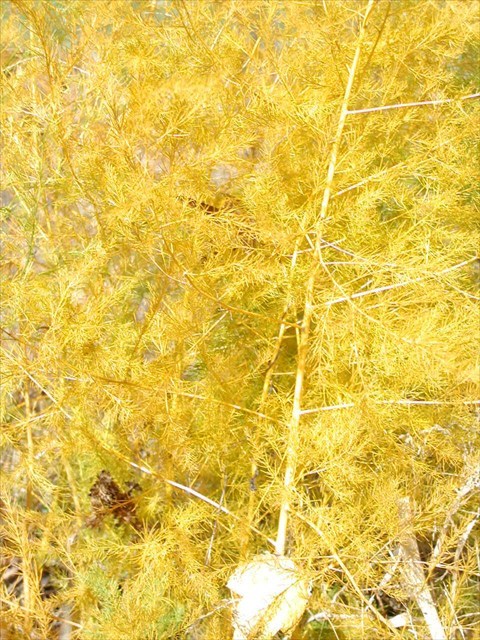
Asparagus foliage turns bright yellow in autumn
The onset of the asparagus urine smell is remarkably rapid while the decline is slower. The smell has been reported to be detectable 15 to 30 minutes after ingestion and subsides with a half-life of approximately 4 hours.
Gallery
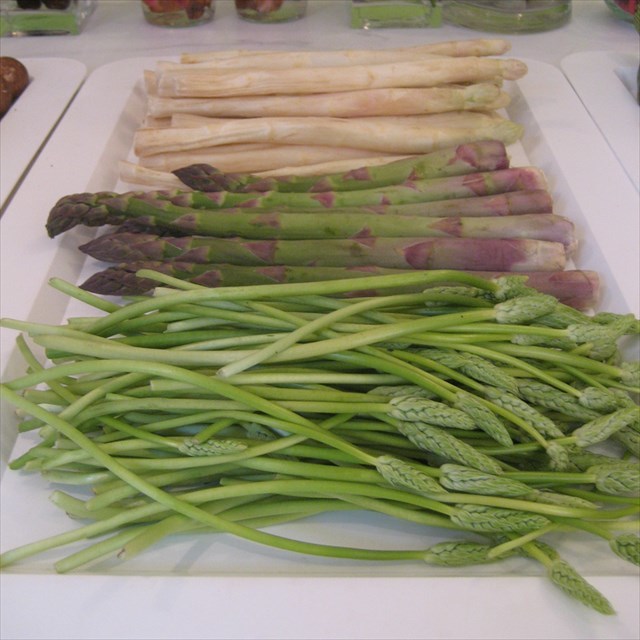
Three types of asparagus are on display, with white asparagus at the back and green asparagus in the middle. The plant at the front is Ornithogalum pyrenaicum, commonly called wild asparagus, and sometimes "bath asparagus".
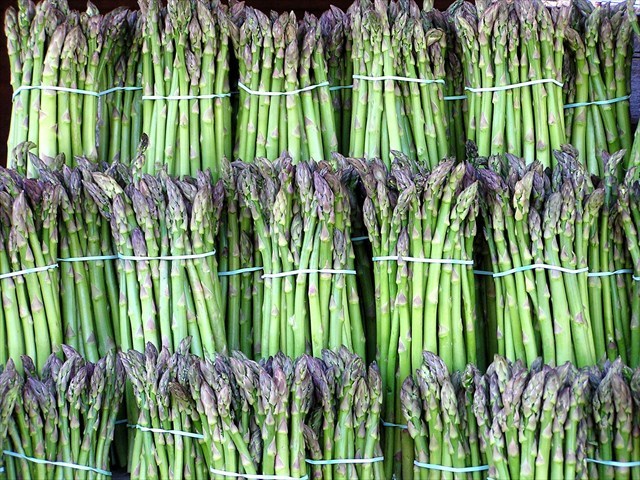
Asparagus for sale
The cache is a tied in, camoed, “small” pill bottle, that you have to push hard to open and close. Please keep track of the contents and put back as you found it. Don’t forget to BYOP!
Additional Hints
(Decrypt)
Jvgpu Unmry, abg Bnx be Ovggrefjrrg.